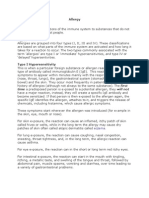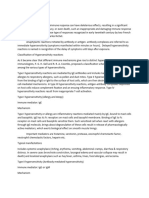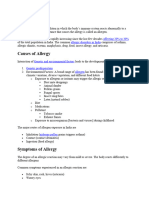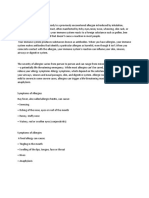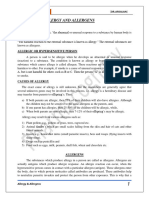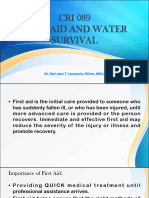Allergy
Allergy
Uploaded by
luvvemulleCopyright:
Available Formats
Allergy
Allergy
Uploaded by
luvvemulleOriginal Description:
Copyright
Available Formats
Share this document
Did you find this document useful?
Is this content inappropriate?
Copyright:
Available Formats
Allergy
Allergy
Uploaded by
luvvemulleCopyright:
Available Formats
Allergy
Definition is an abnormal reaction of the immune system which is characterized by hypersensitivity of an organism to a previously encountered usually harmless
substance.
Etiology & The cause of allergic reaction is allergen. A particle or a substance that provokes allergic response is known as an allergen. Allergens are divided into
Pathogenesis exogenous (allergens that enter the body from without) and endogenous (body cells or tissues). Common exogenous allergens include dust, mold, pollen,
drugs, animal dander, insect venom, poison ivy, food, heat and cold.
There are 3 stages of allergic reaction.
Immune stage – the stage of sensitization. The complex allergen-antibody is formed at this stage. The specific antibodies produced in an allergic reaction
are known as Immunoglobulin E. These antibodies trigger the release of histamine, leukotriene and other chemicals when the organism is exposed to an
allergen.
Pathochemical stage is characterized by release of chemical transmitters (histamine) which trigger the allergic reaction. Histamine causes smooth
muscles of the airways and GI tract to be contracted. It also increases the secretion of mucous production and pruritus. Histamine causes blood vessels to
dilate and become more permeable. In the lungs histamine causes swelling of airways.
Pathophysiological stage is the stage of clinical manifestations.
Methods of Taking anamnesis
diagnostics Skin test – the small amounts of suspected allergen are placed on the skin of the upper arm or back. The skin is scratched to allow entry of the allergen is
injected. Swelling and redness at the test site are considered a positive result. Several allergens are usually tested at the same time.
The Radioallergosorbent Test measures the amounts of specific IgE antibodies in the blood stream. The results are not immediately available.
Blood test which may show the high level of eosinophils.
Clinical pattern Symptoms of an allergic reaction vary depending on the type of allergen, how is entered the system, and the location in the body at which contact
occurred. An inhaled allergen can cause sinus congestion, rhinitis, watery eyes, or wheezing and impaired breathing. An allergic reaction caused by
contact between an allergen and the skin can result in itching, rash, or hives, raised itchy bumps on the skin. An allergic reaction to a food or a drug can
greatly vary and may affect the entire body; reactions may include hives, swelling, or inability to breathe.
Treatment If a food allergy is suspected, one food for a time is eliminated from the diet and then added back to determine if it is triggering the allergic reaction.
Antihistamines are the drugs most often used to control symptoms of allergic reactions.
Symptomatic treatment may be applied. Vasoconstrictors (nasal drops) are used to relieve nasal congestion. Ocular drops are used against red and
watery eyes. Topical ointments with corticosteroids relieve itching.
A shot of epinephrine is given in the case of severe allergic reactions.
Corticosteroids are injected to stop severe allergic reactions such as hives, Quincke’s oedema, anaphylactic shock.
Short-acting bronchodilators provide quick or "rescue" relief from acute bronchoconstriction.
Allergy shots or immunotherapy can be administered to eliminate the allergy entirely. In immunotherapy, a small amount of an allergen is injected in
order to stimulate the body to produce an antibody to neutralize it. This, in turn, blocks the IgE antibodies from reacting with the allergen and provoking
the allergic response.
Complications Quincke’s oedema, anaphylactic shock, asthma attack.
Prevention Keep your home clean and well ventilated
Cut down on dust around your living area by cleaning regularly
Avoid overusing antibacterial substances
Avoid contact with substances that cause allergy
You might also like
- Medical Aspects of Fitness For Work Offshore - Guidance For Examining PhysiciansDocument80 pagesMedical Aspects of Fitness For Work Offshore - Guidance For Examining PhysiciansJamie Taylor100% (6)
- Sample Medical Record - Monica Latte - Agency For Health Research and QualityDocument5 pagesSample Medical Record - Monica Latte - Agency For Health Research and QualityMiraNo ratings yet
- Biology Investigatory ProjectDocument21 pagesBiology Investigatory ProjectCrazy about Jungles88% (34)
- Allergy Article WorksheetDocument3 pagesAllergy Article Worksheetapi-299996815100% (3)
- Research About The Immune System Problems of Clinical Significance "Allergy"Document3 pagesResearch About The Immune System Problems of Clinical Significance "Allergy"Quennzy RegondolaNo ratings yet
- Allergies Takunda Makondo 5th SemesterDocument11 pagesAllergies Takunda Makondo 5th SemestermakondotakundaNo ratings yet
- Presented By: Agamjeet Singh Batra, VI - NDocument27 pagesPresented By: Agamjeet Singh Batra, VI - NlovleshrubyNo ratings yet
- Clinical Pharmacy in - ImmunoallergologyDocument42 pagesClinical Pharmacy in - ImmunoallergologyMai GaberNo ratings yet
- Allergy TestingDocument3 pagesAllergy Testingonline.course556No ratings yet
- ALLERGIESDocument13 pagesALLERGIESpravisankar1978No ratings yet
- Allergies and HypersensitivityDocument14 pagesAllergies and HypersensitivityBabar MushtaqNo ratings yet
- Nursing Care of Clients With Allergic DisordersDocument12 pagesNursing Care of Clients With Allergic Disordersbwee bweeNo ratings yet
- Allergy Service CenterDocument10 pagesAllergy Service Centerpramod454992No ratings yet
- An Allergy Is An Adverse Reaction That The Body Has To A Particular Food or Substance in The EnvironmentDocument15 pagesAn Allergy Is An Adverse Reaction That The Body Has To A Particular Food or Substance in The EnvironmentwengieNo ratings yet
- HypersensitivityDocument15 pagesHypersensitivityTejpalNo ratings yet
- Type1 and Type 2 HypersensitivityDocument65 pagesType1 and Type 2 HypersensitivityJames Carbonell Dela PeñaNo ratings yet
- Allergy: What Is An Allergy?Document5 pagesAllergy: What Is An Allergy?aravindkkk999No ratings yet
- Pathophysiology of AllergyDocument2 pagesPathophysiology of AllergyHoney Pauline PacolorNo ratings yet
- Hypersensitivity in Clinical LaboratoryDocument23 pagesHypersensitivity in Clinical Laboratoryrozhan.kamal34No ratings yet
- Lec # 10 Allergies and HypersensitivityDocument14 pagesLec # 10 Allergies and HypersensitivitysamotherlianNo ratings yet
- Allergy: Time A Predisposed Person Is Exposed To A Potential Allergen, They Will NotDocument5 pagesAllergy: Time A Predisposed Person Is Exposed To A Potential Allergen, They Will NotnaperpedsNo ratings yet
- Allergy: An Overview: Alwa Hassan TeamaDocument38 pagesAllergy: An Overview: Alwa Hassan TeamaFahmi NasrullahNo ratings yet
- AtopyDocument14 pagesAtopyTooba NaeemNo ratings yet
- Nurani Almira Salsabilla-G0018161Document9 pagesNurani Almira Salsabilla-G0018161Rizki AmeliaNo ratings yet
- Anaphylactic ShockDocument29 pagesAnaphylactic ShockHIND100% (8)
- DocumentDocument19 pagesDocumentbaroque.nacNo ratings yet
- AllergyDocument86 pagesAllergyhoor e ainNo ratings yet
- Case Study For AllergyDocument3 pagesCase Study For AllergyGabbii CincoNo ratings yet
- Melanie T. Malirong 11-STEM: Your Future ImmunologistDocument25 pagesMelanie T. Malirong 11-STEM: Your Future ImmunologistMelanie MalirongNo ratings yet
- Main Allergens Diagnosis of Allergic Diseases - Skin Prick Tests 2022Document52 pagesMain Allergens Diagnosis of Allergic Diseases - Skin Prick Tests 2022SePeHR SHNo ratings yet
- ALERGOLOŠKA DIJAGNOSTIKA KOŽNE PROBEDocument16 pagesALERGOLOŠKA DIJAGNOSTIKA KOŽNE PROBERada DopsajNo ratings yet
- Management of Hypersensitivity ReactionDocument6 pagesManagement of Hypersensitivity Reactionmbeng bessonganyiNo ratings yet
- About AllergyDocument13 pagesAbout Allergyprachimohan.mtnlNo ratings yet
- Hypersensitivity Word Document-1Document23 pagesHypersensitivity Word Document-1Dan 04No ratings yet
- Unit 10Document45 pagesUnit 10amirahaliNo ratings yet
- Allergy OutlineDocument6 pagesAllergy Outlineapi-3822433No ratings yet
- Allergic Rhinitis Slides 070926 PDFDocument57 pagesAllergic Rhinitis Slides 070926 PDFmhamad kabraNo ratings yet
- AllergyDocument7 pagesAllergyNG YAN HONG MoeNo ratings yet
- Vol 2 Issue 1013Document22 pagesVol 2 Issue 1013Wardatul MukhlishohNo ratings yet
- Allergy AutosavedDocument11 pagesAllergy AutosavedLeizel Gabin - MoratallaNo ratings yet
- Written Report AllergyDocument4 pagesWritten Report AllergyJapheth ArambuloNo ratings yet
- Alterations With Infectious, Inflammatory, and Immunologic ResponseDocument130 pagesAlterations With Infectious, Inflammatory, and Immunologic ResponseAmerainahDimangadapNo ratings yet
- Allergy and HypersensitivityDocument25 pagesAllergy and Hypersensitivitymrizvi334No ratings yet
- What Is Allergy?: Ascia Information For Patients, Consumers and CarersDocument2 pagesWhat Is Allergy?: Ascia Information For Patients, Consumers and Carersvineeth84No ratings yet
- Holistic Allergy Management: Self-Care, Diet, and HomeopathyFrom EverandHolistic Allergy Management: Self-Care, Diet, and HomeopathyNo ratings yet
- Allergy: Samreen TanveerDocument82 pagesAllergy: Samreen Tanveermehwish qayyum0% (1)
- Seminar WordDocument32 pagesSeminar Wordslmnkhn1988No ratings yet
- READING 3 What-are-AllergiesDocument7 pagesREADING 3 What-are-Allergies0123.185andreNo ratings yet
- Pharma Assignment GROUP No 5Document21 pagesPharma Assignment GROUP No 5Eman RamzanNo ratings yet
- Allergy and AllergensDocument10 pagesAllergy and AllergensAieyan AsifNo ratings yet
- Biology Research On Systemic Lupus ErythematosusDocument13 pagesBiology Research On Systemic Lupus ErythematosusAzfar HuzaimiNo ratings yet
- AllergyDocument17 pagesAllergyHero TasinNo ratings yet
- Allergy: Common Sickness of Individual PersonDocument3 pagesAllergy: Common Sickness of Individual PersonbebeNo ratings yet
- Book-Based: Pathophysiology of Allergic RhinitisDocument2 pagesBook-Based: Pathophysiology of Allergic RhinitisJeraldine Corpuz PascualNo ratings yet
- Rhinitis AllergicDocument9 pagesRhinitis AllergicWiny Ch'amhada TtarudaNo ratings yet
- Drugs For Controlling InflammationDocument7 pagesDrugs For Controlling InflammationNur SanaaniNo ratings yet
- IMMUNOLOGYDocument11 pagesIMMUNOLOGYKiran ShahNo ratings yet
- Allergy Diagnostics and Treatment 2022Document44 pagesAllergy Diagnostics and Treatment 2022Rohan TejaNo ratings yet
- Reactions To Drugs Are AllergicDocument5 pagesReactions To Drugs Are AllergicMuhammad HuzeafaNo ratings yet
- Food Allergens: By: Suraj Kamath Reg. No. Nu20Ahfb14Document17 pagesFood Allergens: By: Suraj Kamath Reg. No. Nu20Ahfb14Suraj KamathNo ratings yet
- Shree Krishna Public SchoolDocument21 pagesShree Krishna Public Schoolharishparsai35No ratings yet
- Bus Network Analysis VulnerabDocument144 pagesBus Network Analysis VulnerabDouglas DíazNo ratings yet
- Soal Bina Utbk Lit B.ingg 5Document6 pagesSoal Bina Utbk Lit B.ingg 5Dimas SaputraNo ratings yet
- Urinary SystemDocument5 pagesUrinary Systemydnic alykPNo ratings yet
- 2020 September by US Part2Document129 pages2020 September by US Part2Ahmed QahtaniNo ratings yet
- Occupational Health Risks Among Cosmetologist: A Case of Kinondoni Municiparity Dar Es Salaam, TanzaniaDocument8 pagesOccupational Health Risks Among Cosmetologist: A Case of Kinondoni Municiparity Dar Es Salaam, TanzaniaIheti SamNo ratings yet
- 09 - Validation of Diagnostic Markers For Streak Virus Disease Resistance in MaizeDocument11 pages09 - Validation of Diagnostic Markers For Streak Virus Disease Resistance in MaizeNemanja NišavićNo ratings yet
- Yds Kelime PDFDocument34 pagesYds Kelime PDFfaithme google100% (1)
- ConjunctivitisDocument15 pagesConjunctivitisPuviyarasiNo ratings yet
- HIV Prevention: HSCI 225 BY Mutua Moses MuluDocument23 pagesHIV Prevention: HSCI 225 BY Mutua Moses MuluJibril MohamudNo ratings yet
- Running Head: CHILDHOOD OBESITY 1Document8 pagesRunning Head: CHILDHOOD OBESITY 1VirginiaNo ratings yet
- PDF Breast Diseases An Evidence Based Pocket Guide Guilherme Novita Ebook Full ChapterDocument53 pagesPDF Breast Diseases An Evidence Based Pocket Guide Guilherme Novita Ebook Full Chapterlaurie.brown340100% (5)
- Neuroscience Pharmacology: Shan NanjiDocument36 pagesNeuroscience Pharmacology: Shan NanjijenniferluzonNo ratings yet
- CORE Diagnostics - Test Menu (External)Document23 pagesCORE Diagnostics - Test Menu (External)Aniruddha KoparkarNo ratings yet
- Project HELP: A Remotely Delivered Behavioral Intervention For Weight Regain After Bariatric SurgeryDocument13 pagesProject HELP: A Remotely Delivered Behavioral Intervention For Weight Regain After Bariatric SurgeryLizbeth MorenoNo ratings yet
- 1 s2.0 S1424390324006355 MainDocument9 pages1 s2.0 S1424390324006355 MainPaul SantiagoNo ratings yet
- L75 - Pathology of CNS TumorsDocument73 pagesL75 - Pathology of CNS Tumorsb deepthiNo ratings yet
- Acid Base Disorder Practice Problems Notes by Giuls 30Document6 pagesAcid Base Disorder Practice Problems Notes by Giuls 30marcoNo ratings yet
- Scaffold 3 ScriptDocument4 pagesScaffold 3 ScriptGeneen LouiseNo ratings yet
- 2014 Book AttentionDisordersAfterRightBrainDamageDocument3 pages2014 Book AttentionDisordersAfterRightBrainDamageVivian Brooklyn ChenNo ratings yet
- A Study To Assess The Effectiveness of Planned Teaching Programme On Knowledge Regarding Iron Deficiency Anemia Among GNM Nursing Students in Selected College of Nursing, Lucknow, U.P.Document5 pagesA Study To Assess The Effectiveness of Planned Teaching Programme On Knowledge Regarding Iron Deficiency Anemia Among GNM Nursing Students in Selected College of Nursing, Lucknow, U.P.Editor IJTSRDNo ratings yet
- Malaria ConvulsionsDocument9 pagesMalaria ConvulsionsAyomide OjabelloNo ratings yet
- Liver Disease Questionnaire For Proposed Insured/OwnerDocument2 pagesLiver Disease Questionnaire For Proposed Insured/OwnerSincerely ReynNo ratings yet
- Mycobacterium Tuberculosis: Paper Esm MicrobiologyDocument15 pagesMycobacterium Tuberculosis: Paper Esm MicrobiologyMuhammad KurniawanNo ratings yet
- Memory Enhancer Pills Cannot Improve One's Memory 1Document10 pagesMemory Enhancer Pills Cannot Improve One's Memory 1Sean VizcarraNo ratings yet
- Final Report GoldsheffDocument38 pagesFinal Report GoldsheffShahzeb Hayat100% (1)
- Manajemen Kegawatdaruratan Pada Syok Neurogenik - Medan - 2022Document41 pagesManajemen Kegawatdaruratan Pada Syok Neurogenik - Medan - 2022zubaidah pasaribuNo ratings yet
- Children Oral Health-Healthcare-ProfessionalsDocument1 pageChildren Oral Health-Healthcare-ProfessionalsAANo ratings yet
- CRI 089 PrelimsDocument74 pagesCRI 089 Prelimsdebroah280No ratings yet




















